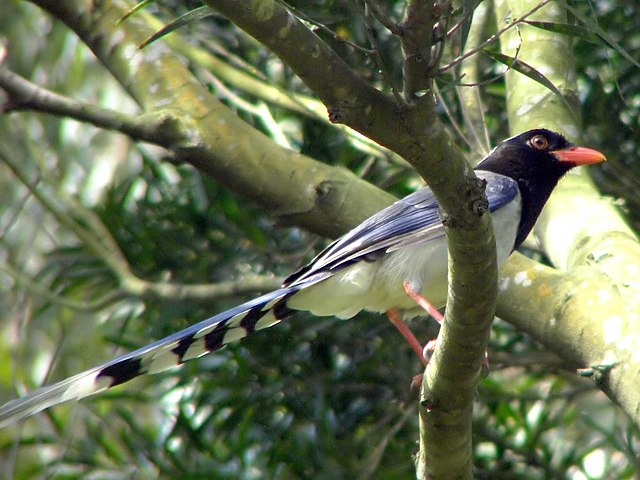Introducing the Red-billed Blue Magpie – a colorful bird that can be found in lowland and foothill forests, gardens, and parks. While this species is known for its striking appearance, it is even more famous for its loud and raucous vocalizations.

The Red-billed Blue Magpie, also known as Urocissa erythrorhyncha in the scientific community, is a member of the Corvidae family, which includes crows. Although it shares similarities in size with the European Magpie, it boasts an impressive longer tail. Its head, neck, and breast are black, with blue speckles on the crown. The shoulders and rump have a slightly less vibrant hue of blue, and the underparts are greyish-cream in color.

The bird boasts a vibrant orange-red color on its bill, legs, feet, and around the eyes, although the intensity of the hue can differ slightly among individuals. However, the standout feature is undoubtedly its lengthy tail, which sports a brilliant blue color and a white tip that spans across a wide area.

The Red-billed Blue Magpie is a bird species that can be found in a vast area spanning from the western Himalayas to China and Vietnam.

This species is mostly found in hilly or mountainous areas, living among evergreen forests and scrubland.

The magpie is a skilled hunter, scouring both the trees and ground for sustenance. Its flexible palate encompasses a diverse range of food sources, from invertebrates and small creatures to fruits and select seeds. However, it has also been observed stealing eggs and vulnerable baby birds from their nests.

This creature is known for its ability to mimic sounds, particularly with its voice. It can produce a variety of different calls, including a rough rattling noise and a high-pitched whistle that sounds similar to a flute.

The Red-billed Blue Magpie is known for making its nests in trees and shrubs, but it doesn’t go too deep. Typically, they lay three to five eggs at a time.

According to the IUCN Red List, this feathered friend is considered to be of minimal concern.

